Mel Chin
Operation Paydirt in New England + Neurotoxic Element Music Video
Artist Mel Chin’s contributions to the Prospectus are based on a project he began in 2006 entitled Operation Paydirt, for which Artists in Context has been the New England coordinator. Mel initiated Operation Paydirt and the Fundred Dollar Bill Project in 2006 to engage communities nationwide to co-create coordinated and innovative solutions to the national crisis of childhood lead poisoning. As a social sculpture Operation Paydirt draws on creative methods to raise awareness, educate, build consensus among stakeholders, and implement a theatrical art performance to collect and deliver Fundred Dollar Bills – original, hand-drawn interpretations of $100 bills – in exchange for actual funding and solutions. Over seven years, the project has grown from a viral initiative involving a few thousand children to nearly 450,000 participants across the country, advancing awareness of lead poisoning prevention.
AIC’s most recent involvement with the project is as co-producer of a work-in-progress hip-hop music video about lead contamination in inner-city soils titled Neurotoxic Element. Mel has created a script, some sketches and an animation test (all posted below) for the video and currently is seeking performers as well as co-producers beyond AIC. Once finished, Neurotoxic Element will be posted on this site and distributed nationally, so stay tuned for its premiere here. (Others interested in co-producing? Please contact us here!)
More information about Operation Paydirt in New England can be found on the AIC website, Mel’s project website, in the Fundred Dollar Bill public service announcement video directly below and in Mel’s texts about the current and next phases of Operation Paydirt that appear on this page.
Fundred Dollar Bill Video PSA
OPERATION PAYDIRT: A Creative Campaign for (EX)Change
Mel Chin’s Operation Paydirt began in New Orleans in 2006 as an artist-initiated project to engage grassroots communities in a creative action to instigate awareness and solutions for the national crisis of lead-contamination. Over seven years the project has grown from a viral initiative involving a few thousand people to engaging over 400,000 participants across the country in advancing lead poisoning prevention awareness, science and remediation. While the ultimate goal of Operation Paydirt has remained the same, the project has evolved interrelated initiatives responding to the complexities of accomplishing real solutions to lead poisoning.
AN INVISIBLE THREAT to CHILDREN: LEAD (Pb)
Toxic forms of lead in paint and gasoline have been banned since the late 1970s, but contamination from our historic use of lead remains in our homes, yards, parks and play fields. This invisible threat in our residential environments puts hundreds of thousands of children at risk, forever compromising their capacity to learn and crippling their future prospects and the well-being of communities.
FREEDOM FROM THIS THREAT IS POSSIBLE
Lead poisoning is preventable and can be stopped. Operation Paydirt wants to contribute its unique method of community engagement to ALL who are working to end the threat. Operation Paydirt’s Fundred campaign allows individuals to create, learn and actively engage. By making this threat visible in a literal and valuable way, the path to health and solutions can be delivered right to individuals, communities and policy makers.
OPERATION PAYDIRT MOVING FORWARD
Operation Paydirt started in New Orleans with an intention: to find a solution for the national crisis of lead-contaminated soil and to engage the affected communities in a creative action to instigate change. Since then, Operation Paydirt has provided the protocol to the EPA to transform a California neighborhood plagued by lead. It was also behind a HUD grant to maximize the transformation of toxic lead in soil in New Orleans. Moving forward, the focus has expanded beyond soil to all forms of lead poisoning in all places.
FUNDREDS SPEAK
Operation Paydirt’s creative grassroots Fundred campaign has raised awareness of the issue, with nearly 400,000 participants from 47 states so far. Fundreds, individually hand-drawn versions of the U.S. One Hundred Dollar Bill, represent the values of creativity, intelligence and health that are compromised by lead-poisoning.
CONGRESSIONAL DELIVERY: A Call for (EX)Change
Fundred drawings are a new way to engage millions in a democratic process. As the voice of the people, as a monetary measure of their hopes, Fundreds will be delivered to the U.S. Congress where a request will be made for an Even Exchange – Fundreds for real dollars and programs to end this preventable environmental threat. The Fundreds, along with the method to make cities lead-safe, will be delivered in a celebratory event. Participants from across the country will be in attendance to witness the transfer and the impact of their collective effort.
Operation Paydirt in New England
This is a small sampling of the thousands of Fundreds created at workshops conducted by AIC in the region in 2010.
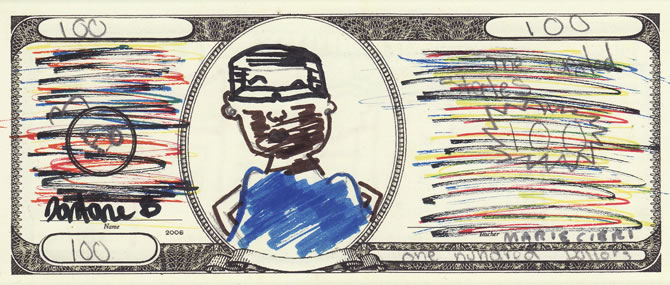
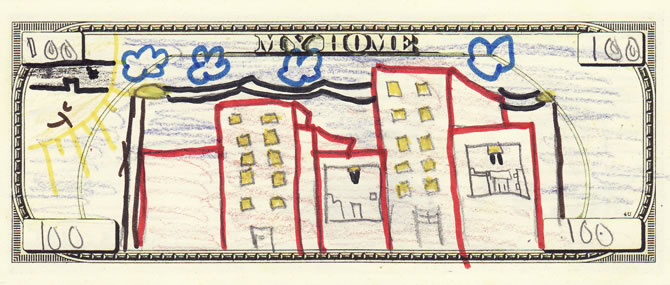


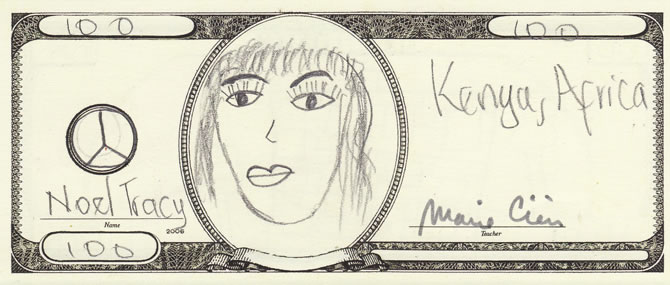

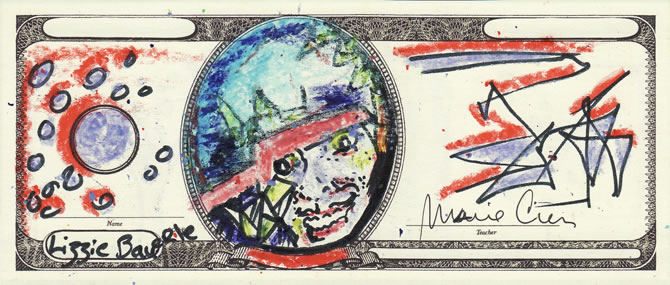

Some Fundred-making on the Southside of Providence, RI, and the Fundred armored collection truck in the Tropical Foods parking lot in the Roxbury neighborhood of Boston. Photos below by Marie Cieri.
CURRENT INITIATIVES
Neurotoxic Element Music Video: Being one of the producers of this music video represents AIC’s most recent involvement in Operation Paydirt. Still in conceptual phase, Mel created a script for a hip-hop music video about the project (script posted below). He currently is seeking other producers as well as performers; see storyboard sketch, sketch of the N Toxic Cast and animation test below.
Charlotte Initiative: Carried out in collaboration with McColl Center for Visual Art, Lead Safe Charlotte, The Green & Healthy Homes Initiative and SmartLab, this initiative resulted in a video PSA (see at top of this page) and lesson plan combining Fundred with lead poisoning prevention outreach in Charlotte area schools. This test city-based project and collateral material will inform the next phase of national outreach.
The MAKE it REAL Workshop: The project is in collaboration with MIT’s CoLab to organize a workshop for a broad multi-disciplinary, cross-sector group to agree on the state of the problem, consolidate the evidence, and identify objectives and solutions to protect children from the hazard of lead contamination. Looking at the problem through multiple lenses (e.g. science, public health, education, criminology, policy, community engagement, economics, etc.), participants will outline a compelling evidence package (e.g., communicating the depth of lead’s impacts) and solution package (e.g., model programs, funding requirements, policy asks) to which a politician can respond and can use in building support for legislation.
L.A. Freewaves Animated PSA: Commissioned by Freewaves L.A., Mel Chin is collaborating with animator Careen Ingle to create an animated educational public service announcement that will be screened on 2,200 Los Angeles county buses.
Neurotoxic Element, music video work-in-progress, Mel Chin’s future Prospectus contribution, Artists in Context co-producer.
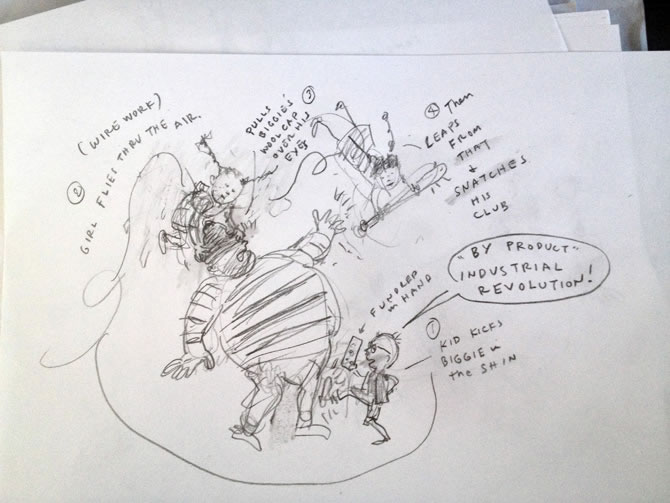
Mel Chin, Neurotoxic Element, storyboard sketch, 2013
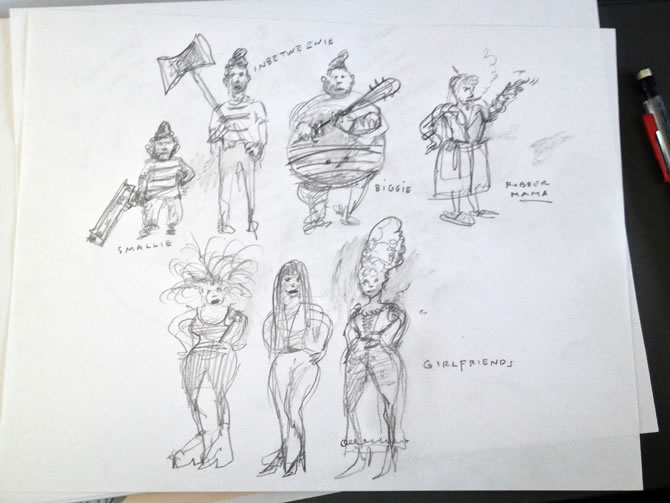
Mel Chin, Quick Sketch of the N Toxic Cast, 2013
https://vimeo.com/66073867
Mel Chin Animation Test, Intro for Neurotoxic Element: 02.15.2013
Duration : 30 sec. By Ben Permeaux and Scott Lazes

Mel Chin, ca. 2008, New Orleans, photo by Anne Senstad
Mel Chin was born in Houston, TX, in 1951. Chin’s art, which is both analytical and poetic, evades easy classification. He is known for the broad range of approaches in his art, including works that require multi-disciplinary collaborative teamwork, and works that conjoin cross-cultural aesthetics with complex ideas. He developed Revival Field (1989-ongoing), a project that has been a pioneer in the field of “green remediation,” the use of plants to remove toxic, heavy metals from the soil. These projects are consistent with a conceptual philosophy which emphasizes the practice of art to include sculpting and bridging the natural and social ecology.
Chin is well known for his iconic sculptures, works that often address the importance of memory and collective identity. Such work fuses formal aesthetics with political critique and lamentation. Chin also insinuates art into unlikely places, including destroyed homes, toxic landfills and even popular television, investigating how art can provoke greater social awareness and responsibility. Chin’s socially engaged projects also challenge the idea of the artist as the exclusive creative force behind an artwork. “Sometimes, the survival of my own idea may not be as important as a condition I might create for others’ ideas to be realized,” says Chin, who often enlists entire neighborhoods or groups of students in creative partnerships. From 1995-1998 he formed the collective the GALA Committee that produced In the Name of the Place, a conceptual public art project conducted on American prime-time television. In KNOWMAD, Chin worked with software engineers to create a video game based on rug patterns of nomadic people facing cultural disappearance. Chin also promotes “works of art” that have the ultimate effect of benefiting science, as in Revival Field, and also in the recent Fundred Dollar Bill/Operation Paydirt Project, an attempt to help end childhood lead (Pb)-poisoning and offer a path toward lead-safe cities throughout America.
Chin’s work was documented in the popular PBS program, Art of the 21st Century. His proposal for a New World Trade Center was part of the American representation at the 2002 Venice Biennale of Architecture. A major one-person exhibition, Do Not Ask Me, was seen at the Station Museum, Houston, TX, in 2006 (forthcoming catalog to be published by Station Museum, distribution by D.A.P.) His film, 9-11/9-11, a hand-drawn 24-minute joint Chilean/ USA production, won the prestigious Pedro Sienna Award, Best Animation, National Council for the Arts and Cultures, Chile, in 2007. He was awarded the Fritschy Culture Award 2010 and was a finalist for the International Award for Participatory Art in Bologna, Italy. He received the 2012 Public Art Network Award from Americans for the Arts. He is currently a Knight Fellow in Residence at the McColl Center for the Arts in Charlotte, NC.
Chin received a B.A. from Peabody College in Nashville, Tennessee, in 1975. With numerous awards and grants from organizations such as the National Endowment for the Arts, New York State Council for the Arts, Art Matters, Creative Capital and the Penny McCall, Pollock/Krasner, Joan Mitchell, Rockefeller and Louis Comfort Tiffany Foundations, Chin has created many commissions, public art installations and one-person exhibitions around the world. Venues for solo exhibits have included: Storefront for Art and Architecture, NYC; Hirshhorn Museum and Sculpture Garden, Washington, DC; Walker Art Center, Minneapolis; the Menil Collection, Houston; and the Fabric Workshop, Philadelphia.
Projects and public commissions have been installed at diverse sites such as New York City’s Central Park; Pig’s Eye Landfill in St. Paul; Floriadepark in rural Netherlands; Eco Tec International in Corsica; the San Jose Public/State University Library, San Jose, CA; Pittsburgh’s Three Rivers Arts Festival; The New York Times Magazine; West Queens High School, Queens, NY; the City of Corpus Christi, TX; and the St. Roch neighborhood, New Orleans, LA. Group show venues have included: Fifth Biennial of Havana, Cuba; Museu d’Art Contemporani de Barcelona, Spain; Kuntsmuseum, Bonn, Germany; Kwangju Biennale, Korea; Smithsonian Museum, Washington, D.C.; Museum Of Contemporary Art, Los Angeles, CA; and the Whitney Museum of American Art, P.S. 1 and Museum of Modern Art, New York, NY.
Chin has been awarded three Honorary Doctorates from RISD, Providence, RI; MICA, Baltimore, MD; and Green Mountain College, Poultney, VT.







